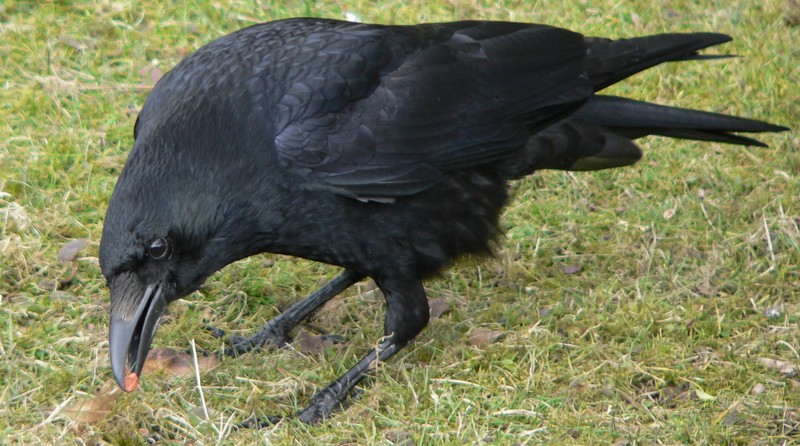| 새로운 사진 | 신문속의 동물소식 | 신기한 동물이야기 | 동물의 소리 | 동물동화상 | 사진 올리기 | 사진 저작권 | English |
|---|
| 재미있는 동물사진 | 괴수/괴어/엽기 동물사진 | 동물이름사전 | 동물목록 | 바깥고리 | 창고입구 | 똑똑누리집 |
|---|
| 이미지 정보 | Original File Name: Carrion Crow (Corvus corone)_Rabenkr??he_1.jpg Resolution: 1977x1101 File Size: 586397 Bytes Upload Time: 2007:12:03 10:33:34 | |
| 올린이 | 이름 (메일주소): Unknown | |
| 사진 제목 | Carrion Crow (Corvus corone) - Wiki | |
 |
| Email : 카드 | 올린이 | 운영자 사진삭제 정보수정 Admin |
| 설명 | Carrion Crow (Corvus corone) - Wiki
Carrion Crow
The Carrion Crow (Corvus corone) is a member of the passerine order of birds and the crow family which is native to western Europe and eastern Asia. Taxonomy The Carrion Crow was one of the many species originally described by Linnaeus in his 18th century work Systema Naturae and it still bears its original name of Corvus corone. The specific epithet corone/κορωνη is the Greek word for "crow". As well as the subspecies of the Hooded Crow being split off as a separate species, there is some discussion whether the eastern race of the Carrion Crow, orientalis is distinct enough to warrant specific status; the two taxa are well separated, and it has been proposed they could have evolved independently in the wetter, maritime regions at the opposite ends of the Eurasian landmass. Description The plumage of Carrion Crow is black with a green or purple sheen, but the gloss is much greener than that of the Rook. The bill, legs and feet are also black. It can be distinguished from the Common Raven by its size (48???52 cm in length) and from the Hooded Crow by its black plumage, but there is frequent confusion between it and the Rook. The beak of the Crow is stouter and in consequence looks shorter, and whereas in the adult Rook the nostrils are bare, those of the Crow are covered at all ages with bristle-like feathers. Distribution and habitat This species breeds in western and central Europe, with an allied form or race C. c. orientalis (50-56 cm in length) occurring in eastern Asia. The separation of these two populations is now believed to have taken place during the last ice age, with the closely allied Hooded Crow (now given species status) filling the gap between. Fertile hybrids occur along the boundary between these two forms indicating their close genetic relationship. Behaviour The Rook is generally gregarious and the Crow solitary, but Rooks occasionally nest in isolated trees, and Crows may feed with Rooks; moreover, Crows are often sociable in winter roosts. The most distinctive feature is the voice. The rook has a high-pitched kaaa, but the Crow's guttural, slightly vibrant, deeper croaked kraa is distinct from any note of the rook. The Carrion Crow is noisy, perching on the top of a tree and calling three or four times in quick succession, with a slight pause between each series of croaks. The wing-beats are slower, more deliberate than those of the Rook. Diet Though an eater of carrion of all kinds, the Carrion Crow will kill and eat any small animal it can catch, and will also steal eggs. Crows are scavengers by nature, which is why they tend to frequent sites inhabited by humans in order to feed on their household waste. Nesting The bulky stick nest is usually placed in a tall tree, but cliff ledges, old buildings and pylons may be used as well. Nests are also occasionally placed on or near the ground. The nest resembles that of the Common Raven, but is less bulky. The four to six brown-speckled blue or greenish eggs are incubated for 17-19 days by the female alone, who is fed by the male. The young fledge after 32-36 days. It is not uncommon for an offspring from the previous years to stay around and help rear the new hatchlings. Instead of seeking out a mate, it looks for food and assists the parents in feeding the young. http://en.wikipedia.org/wiki/Carrion_Crow
| |||
| 저작권 정보 | 사진의 저작권은 원저작자에게 있습니다. 동물그림창고는 동물관련 사진을 전시할 수 있는 공간만을 제공합니다.사진을 사용하고자 할 경우에는 저작권자와 협의하시기 바랍니다. |
|
|
|
| |||||||
| CopyLeft © since 1995, 동물그림창고. All rights may be reserved. | ||||||||
Stats